Last updated: January 13th, 2024
Today’s lightest hybrid bikes weight about 19-21 lbs.
And if you’ve got the cash, I’ve got the list.
Whether you call them “hybrid” or “fitness” or “flat-bar road,” here are the absolute lightest* models on the market:
- Canyon Roadlite CF 9 LTD (18.2 lbs) – Lightest Hybrid
- Specialized Sirrus 6.0 (20.2 lbs)
- Trek FX Sport 6 (20.5 lbs)
- Litespeed Cherohala City (~21 lbs**)
- Specialized Sirrus X 5.0 (21.1 lbs)
- Giant FastRoad Advanced 1 (21.6 lbs)
- Obed Borough Grid (~22 lbs**)
- BMC Alpenchallenge 01 TWO (22.0 lbs)
- Fuji Absolute 1.3 (23.0 lbs) – Best Value
* Based on manufacturers’ published weights where available, or an average of third-party reported weights in other cases. When possible, all are based on a size medium.
** Denotes my educated guess, since no credible weight estimates were available as of publishing.
None of these (except perhaps the Canyon) will impress road-bike weight weenies
But compared to typical hybrids that come in around 25–30 lbs, these feel almost unbelievable snappy.
Pro tip: The best bang for your buck is an aluminum frame with carbon rims. They contribute to rotating mass, which makes a bigger different than static mass like your frame and fork. If cost is a constraint, then minimize the weight of spinning or moving parts first.
By the way, these featherweights are geared toward the pavement side of the spectrum.
They’re not for tearing up a little singletrack or getting knocked around public bike racks.
If that is what you’re after, then check out the more robust models in my budget hybrids guide. Most have upgraded siblings, which are still heavier, but also burlier than you might think.
This article might contain affiliate links. As a member of programs including Amazon Associates, I earn from qualifying purchases.
Canyon Roadlite CF 9 LTD
At just 18.2 lbs, Canyon’s flagship Roadlite CF 9 LTD is 2024’s lightest hybrid off the rack.
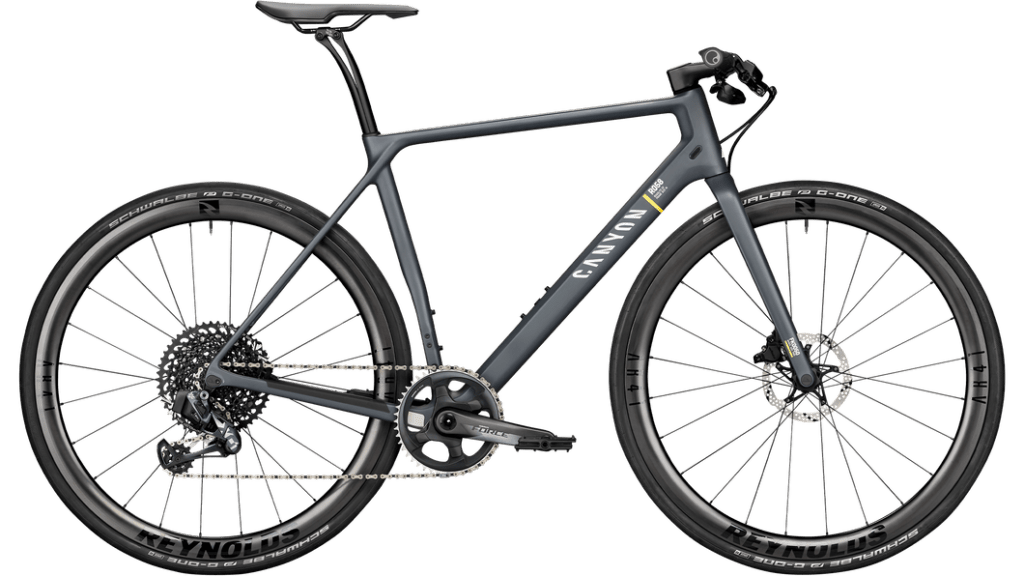
Its carbon frame and fork are standard fare in this tier, but the carbon wheelset is what really stands out. Not only does that minimize overall weight, but it’s specifically a reduction in rotating weight, so you’ll enjoy quicker acceleration and an overall nimbler feel.
Components are the cream of the crop, in keeping with its hefty $3649 MSRP. Your money buys electronic shifting in the form of a 1×12 SRAM X01 Eagle AXS eTap derailleur, tubeless-ready Reynolds AR41 rims, and small but thoughtful touches like Ergon GA3 grips on the all-carbon cockpit.
Specialized Sirrus 6.0
Specialized’s Sirrus line runs the gamut from solid, entry-level commuters to today’s featured model: the impressively-spec’d Sirrus 6.0, which comes in at about 20.2 lbs.
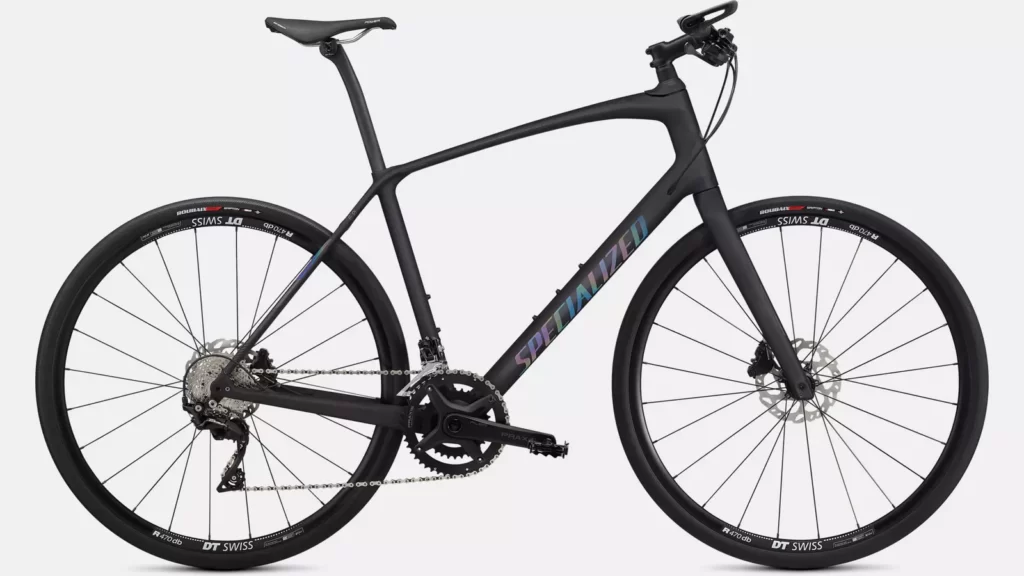
Like the Canyon model above, the Sirrus 6.0 is built around a full-carbon frame and fork. But it has a trick up its sleeve: the Future Shock 1.5 adds just under an inch of coil-sprung suspension to take the edge off rough roads. It fits discreetly inside the head tube and should require no maintenance under normal use.
The alloy cockpit and tubeless-ready alloy rims leave some weight savings on the table, and the Shimano 105 2×11 drivetrain is underwhelming for a sticker price of $3000. But if you’re sold on the Future Shock’s lightweight, low-tech suspension, then it’s a worthy contender that may be easy to find locally.
Trek FX Sport 6
Next in the all-carbon cohort at 20.5 lbs, we have Trek’s FX 6—the premium offering in their extremely popular FX hybrid line.
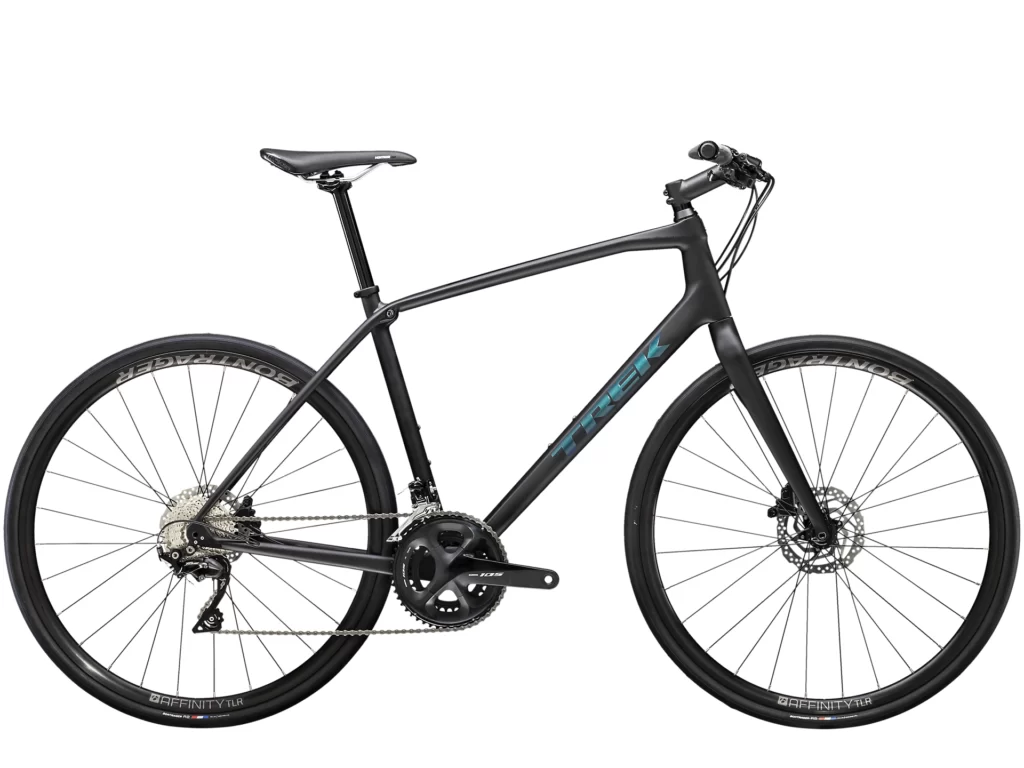
The FX 6 is Trek’s counterpart to the Sirrus 6.0, using a similar carbon frame and fork coupled with an alloy cockpit, tubeless-ready alloy wheelset, and Shimano 105 2×11 drivetrain.
But unlike the Sirrus, there’s no suspension mechanism built in. Instead, it has Bontrager IsoZone handlebars and grips, which essentially stick an elastomer layer under your hands. (The branding is a little over-the-top, since good ergonomic grips would accomplish the same thing on any bike for about $50.)
And also unlike the Sirrus, you can snag an FX 6 for a more appealing $2200—provided you’re comfortable on the FX frame’s longer reach and lower stack.
Litespeed Cherohala City
Litespeed is not a large brand, but they’ve been making high-end titanium bikes in Tennessee for longer than I’ve been alive. Their Cherohala City is their popular Cherohala all-road frame in a slightly more rugged flat-bar build kit.
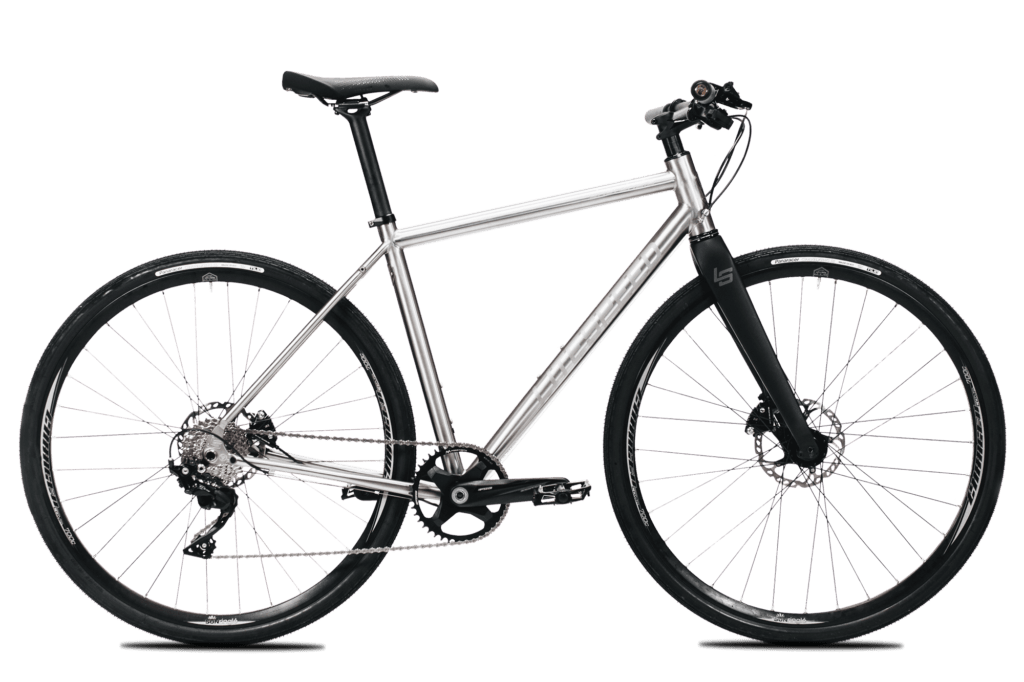
The titanium frame and carbon fork should theoretically outlast fully carbon construction, or at least withstand a few more bumps on the way, but most fans of titanium point to silky-smooth ride quality as the top selling point.
The $2995 baseline build kit includes a 1x Shimano 105 drivetrain and TRP mechanical discs (one of the better mechanical discs I’ve ridden to date), which the $3695 package upgrades to Shimano’s 1x Ultegra drivetrain and MT201 hydraulic discs. I don’t foresee enough difference to justify the extra $600, especially seeing as both price point use an alloy cockpit and bars.
However, I’d happily fork out another $350 to upgrade the standard Sun Charger Comp tubeless wheels to the optional Stan’s Grail MK3, which drop roughly a pound of rotating weight.
Specialized Sirrus X 5.0
Here’s a little secret: flat-bar gravel bikes and hybrids are just about the same. I suppose we can quibble over bottom bracket height and ±1° head-tube angle, but we’re not talking about major differences. But “gravel bike” carries enough cachet that some brands—ahem, Specialized—can command quite a bit more for very, very similar designs.
All that by way of introducing the Sirrus X 5.0, a more rugged, 21.1-lb sibling to the aforementioned Sirrus 6.0. And, as it happens, a cheaper alternative to the only slightly fancier Diverge Expert E5 EVO gravel bike.
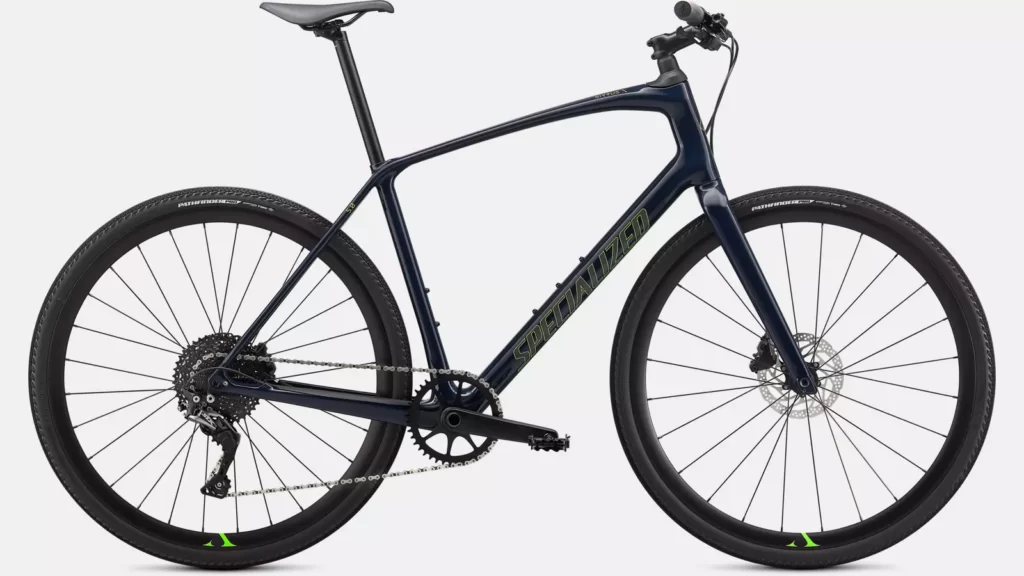
To the best of my knowledge, its carbon frame and fork with Future Shock 1.5 “suspension” are identical to the Sirrus 6.0—and they perfectly straddle the line between hybrids versus mountain bikes.
The main differences that give the Sirrus X 5.0 a little more all-terrain capability are its 38mm tires and clutch-equipped Shimano SLX 1x drivetrain. There are also small cockpit differences, like ditching the bar ends and carbon seatpost, but these won’t make a major difference.
At $1900, this is one of the better values on this list—all the more so compared to its high-end Specialized brethren. Although the Sirrus 6.0 is slightly more svelte, its components are too similar to justify its massive price increase.
And as for the Diverge Expert E5 EVO? For $700 more, you’ll get the hydraulically-damped Future Shock 2.0, a dropper post, an XT derailleur, and an enviable 700c x 47 mm / 650b x 2.1″ of tire clearance. The Diverge frame creates a longer, lower posture than the Sirrus, which spells speed to some but back pain to others.
Those differences aren’t exactly game-changing, but they’re arguably worth the extra cash if you spend the vast majority of your time off-road (yet don’t want a rigid or hardtail mountain bike). For everyone else—including the quintessential hybrid customer who wants to do a bit of everything—the Sirrus X 5.0 is a significantly better deal.
Giant FastRoad Advanced 1
Turning to the last of the US bike mega-brands, we have Giant’s FastRoad Advanced 1 at a reported 21.6 lbs.
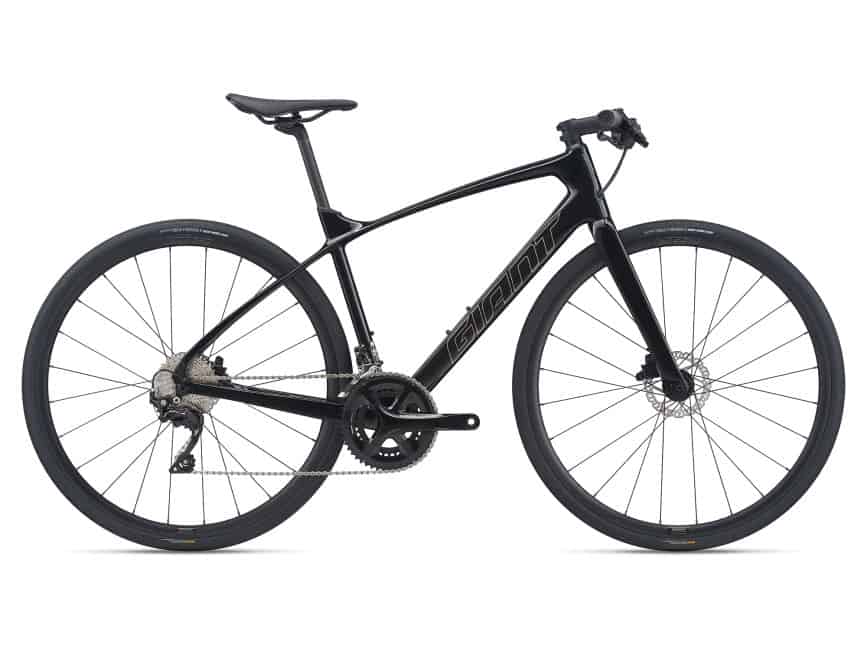
Akin to the Trek FX 6 and Specialized Sirrus 6.0 model, the top-end FastRoad also uses a carbon frame and fork, a Shimano 105 2×11 drivetrain, and tubeless-ready alloy wheels. Its carbon seatpost should dampen vibrations and cut grams, although the bars and stem are alloy.
At $2290, it’s priced neck and neck with the FX 6 but a good deal below the Sirrus 6.0. On paper, the FastRoad’s riding position should be a little more upright (higher stack and shorter reach) than the FX, but roughly similar to that of the Sirrus.
Obed Borough Grid
Rounding out the all-carbon contingent is the approximately 22-lb Borough Grid hybrid from Tennessee’s Obed bikes.
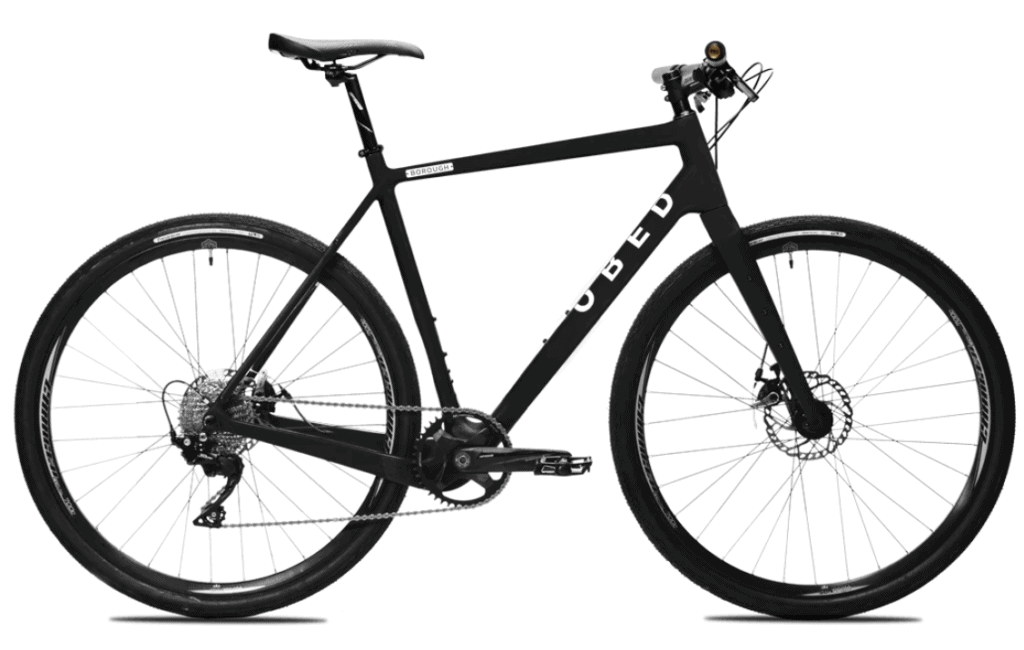
Specific weight figures were exceptionally hard to find, so take this one with a grain of salt. That said, it’s well in keeping with other bikes using a carbon frame and fork, Shimano Ultegra 1x drivetrain, and tubeless Stan’s Grail alloy wheels. (Yes, tubeless from the factory!)
The Borough Grid comes in at a steep at $3349, within striking distance of the significantly lighter Canyon Roadlite CF 9 LTD. Unlike Canyon, Obed stuck with alloy cockpit parts that sacrifice a little bit of weight for robustness. Also unlike Canyon, Obed gave 43mm tire clearance and partially-upright geometry that’s perfect for casual/practical riding (versus the Roadlite’s 30mm tires and deeper forward lean.)
You can save on the baseline, Shimano 105-equipped Borough. It uses the same frame and fork but sells for either $2495 with heavier Sun rims (adding nearly a pound) or $2845 with the same Stan’s rims. However, the baseline spec also drops the Shimano hydraulic discs in favor of TRP mechanical discs—which is a little disappointing, even at the lower (not remotely cheap!) price point.
BMC Alpenchallenge 01 TWO
Switzerland’s BMC is staple of road bike round-ups, and their Alpenchallenge line translates similar designs into flat-bar form. And at 22.0 lbs, the Alpenchallenge 01 TWO is the lightest of the lot.
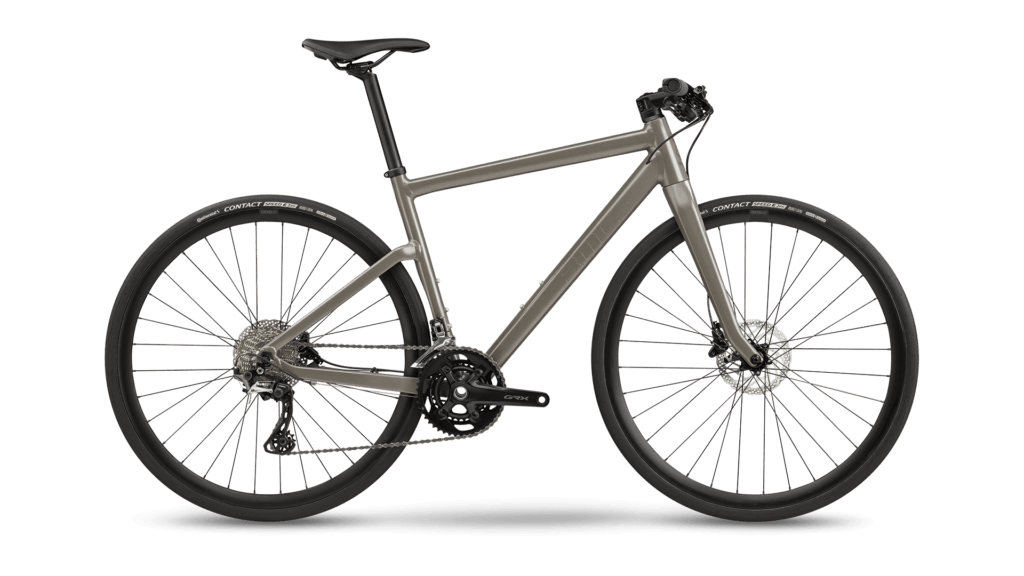
It uses an alloy frame and carbon fork, alloy cockpit, and tubeless-ready alloy rims from DT Swiss.
The Shimano GRX 2×11 drivetrain is a cool touch—essentially the clutch-equipped “gravel” version of Ultegra line—and the Shimano hydraulic discs are plenty powerful for any situations you’ll want to ride this bike in.
These are impressive specs for $1799. One imagines the lower cost of an aluminum frame let BMC put the difference into the parts list.
(You might have noticed that this “TWO” model isn’t technically the top of the line. That honor goes to the “ONE.” But the latter is actually over 3 lbs heavier, since it adds an Alfine internally-geared hub and belt drive. IGHs are great for many things, but saving weight is not one of them.)
Fuji Absolute 1.3
To wrap things up with a budget pick, we have Fuji’s Absolute 1.3 coming in (reportedly) around 23 lbs.
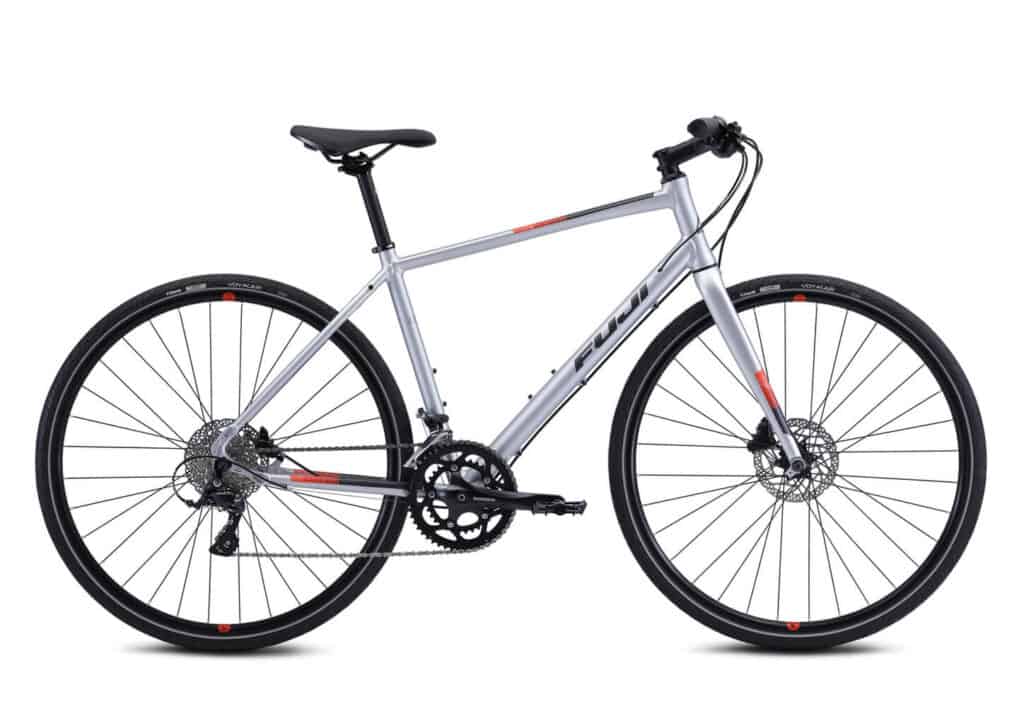
The alloy frame and carbon fork are exactly as expected on a mid-level model. Same goes for the house-brand alloy cockpit. Fuji doesn’t specify which alloy rims from Alex they’ve used, but Alex rims tend toward the strong-but-heavy side.
The 2×9 Shimano Sora drivetrain is more than adequate, if not as crisp-feeling as the 105 (and up) we’ve seen above. That said, the Shimano hydraulic discs are a great choice, and more practically useful than a fancier derailleur.
At $1149, the Absolutely 1.3 is well above the entry-level price point (like the best budget hybrids covered previously), but it’s also a few pounds lighter than any inexpensive model. And considering the added cost for something significant lighter than the Absolute 1.3, this falls in the price-weight sweet spot for a lot of cyclists.
Two important questions before you buy
What’s the easiest way to make my hybrid bike lighter?
If you’re currently riding a hybrid that isn’t a total clunker, then try going tubeless before replacing the entire bike. That’ll drop around 3 oz per wheel—not an impressive number, but surprisingly noticeable since it’s all rotating weight. Stan’s NoTubes is the go-to for conversion kits, but drop by your local bike shop first to confirm whether your existing rims are easy to convert.
A new, tubeless-ready wheelset solves any conversion issues and may cut more than a pound of rotating weight. But a worthy wheel upgrade can run $500-$1000, so that might be a case where a new bike is actually most cost-effective. (And if that’s on the table, then check out this article on the best time to buy a bike.)
You can also trim a little more weight with carbon-fiber versions of, well, just about anything. Keep in mind that prices for quality aftermarket composites parts can be eye-watering, so it’s not the best bang for your buck.
Does saving weight make sense for you?
This is important on two levels.
The first is financial. Bike weight reduction can be a slippery slope, so I try to take a cost-benefit approach.
A hybrid with high-end carbon everything will have terrific ride quality and, obviously, light weight. We can take that for granted. The real question is whether doubling or tripling the price will also double or triple your enjoyment of the ride.
There’s no wrong answer.
It’s perfectly fine to earnestly say, “Of course I won’t enjoy it three times as much, but I still like it more, and I can easily afford it!”
But if you’re expecting a featherweight bike to kindle a love for the sport or a passion for exercise that you’ve never had—or even just to make big hills feel like a breeze—you’re in for disappointment. A bike of any weight is a machine, and that’s asking too much of it.
The other level is strictly practical. Will you need to lock the bike to public racks where every exposed surface will, eventually, get gouged and knicked? Will you carry cargo or heavy accessories that add back all the weight you’ve paid through the nose to save?
A sub-20-lb hybrid might be a blast to ride unladen, but the snappiness disappears under a stuffed commuting pannier.
